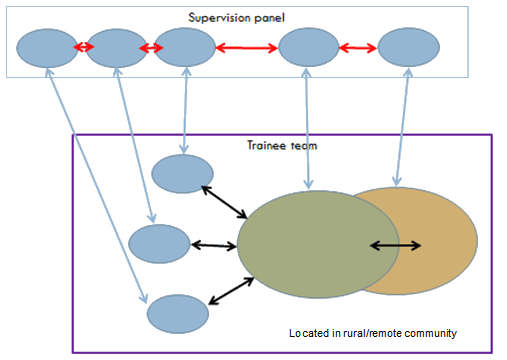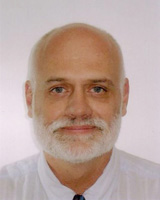A period of supervision in practice is an essential part of professional training for rural general practice in Australia1,2. Registrars work closely with nominated supervising clinicians and can seek advice and support whenever needed. Supervisors can observe registrars closely, provide timely feedback and assessments based on many interactions. The normal model places the registrar and the supervisor in the same practice, a not unreasonable expectation, but this does potentially disadvantage those seeking training for more remote practice, where there may not be another, experienced medical practitioner to provide supervision. This potentially limits the preparation of registrars for more remote styles of practice, and constrains the recruitment of doctors to smaller and more remote communities.
As with many innovations in remote practice, a solution to this problem arose from necessity. Almost 20 years ago the plight of rural GP registrars who were State Rural Scholarship holders was noticed. These recent graduates were often posted to places struggling to recruit doctors: the smaller, sometimes one-doctor communities where local supervision was not possible. It had been observed that the presence of a supervisor did not necessarily lead to good supervision: this requires a sound professional relationship, self and mutual awareness of strengths and weakness, confidence to seek and provide help at any time, and the ability to provide and receive appropriate feedback3. A model was therefore developed by which these attributes of clinical supervision would be provided for at least part of the training, with supervisors and registrars based in different communities, but communicating well and often. The aims were to assist registrars to participate in formal training and to develop the necessary degree of self-reliance, supported by a strong network comprising distant mentors in a wide range of specialties, with the assistance of selected rural practice supervisors. The model also offered the practical advantage of placing intending rural doctors in areas where they can make a substantial contribution to the medical workforce and, therefore, to the care of the local communities.
Evaluation of the original trial showed clearly that distance was less of a barrier than many thought it would be. Trainees and supervisors were able to interact frequently, through a combination of workshop attendances, practice teaching visits and telephone discussions4. Indeed the level of contact was similar to that between trainees and supervisors in the same practice. Since that time, the Pilot Remote Vocational Training Scheme (PRVTS) and, more recently, the Remote Vocational Training Scheme (RVTS)5, have developed and implemented the model with considerable success (RVTS management; pers. comm.; 2012). A more recent update is that a total of about 70 GP registrars have been through the program, with 63 achieving Fellowship of the Royal Australian College of General Practitioners (RACGP), the Australian College of Rural and Remote Medicine (ACRRM), or both Colleges6. There are currently 70 remote GP registrars in training and 81 trained remote supervisors, some of whom were trained through remote supervision. Their locations are widely dispersed across rural and regional Australia, but distance is less relevant because of the continuing development of communications technology. Hence, by most measures the program has been successful6.
The model thus far, however, has been restricted to rural general medical practice training. While the need for this pathway remains, health workforce shortages also exist in rural and regional Australia for almost all other health professions, including nursing, dentistry, physiotherapy, occupational therapy, speech pathology and social work. These professions mostly lack the mandatory postgraduate training requirements common to all medical specialist pathways, with current postgraduate training options generally leading to narrower, more specialised careers not readily available in rural and regional communities. Further, the training programs for other medical specialties, such as general medicine, surgery, paediatrics, obstetrics and gynaecology and psychiatry, are largely urban-based, even though there are visiting services to many rural and regional communities that could provide opportunities to learn about more remote practice.
It may be time to consider extending the remote supervision model potentially to all health professions. The most attractive model is interprofessional, building on the more overtly teamwork-based model found in rural practice7. Not all trainees necessarily need to be permanently based in the chosen rural community, depending on the target population, as some could be based in a larger centre but visit regularly. When in the rural community, the remote trainees would work together, forming a remote healthcare team, and be supervised by profession-specific supervisors in other centres, forming a supervision panel or team. Day-to-day team membership 'on the ground' of both trainees and supervisors may vary according to which services are in the community. The primary relationships would be within each profession, but opportunities would be taken for group case-discussions focused on the health care of patients needing the services of more than one profession. The model is presented conceptually (Fig1).

Figure 1: Remote supervision: local trainee and distant supervisor teams.
The large circles represent full-time presence in the rural community.
There is potential for this model to further enhance healthcare service in the chosen rural communities, which need the services of a wide range of health professions, as do urban communities. It may be complex to organise and require additional funding, perhaps involving the National Rural Health Alliance and an extension of the current RVTS, but there is potential to enhance rural health care. There may also be a place for a formal rural practice qualification for those professions currently without one. Anyone for a pilot of the extended model?
Acknowledgement
This article is based on a keynote presentation at the inaugural Remote Medical Education Conference held 27-28 July 2012 in Sydney, Australia.
Richard B Hays, MD, PhD, FRACGP, FACRRM
Faculty of Health Sciences and Medicine, Bond University
Robina, Queensland, Australia
References
1. Royal Australian College of General Practitioners. Vocational Training Standards. (Online) 2005. Available: http://www.racgp.org.au/vocationaltraining/standards (Accessed 1 August 2012).
2. Australian College of Rural and Remote Medicine. Primary Rural and Remote Medical Training. (Online) 2010. Available: http://www.acrrm.org.au/vocational-training (Accessed 1 August 2012).
3. Hays RB. Practice-Based Teaching: A guide for General Practitioners, 2nd Edn. Eruditions, Melbourne, 2006.
4. Hays RB, Peterson L. Options in education for advanced trainees in isolated general practice. Australian Family Physician 1996; 25(3): 362-366.
5. RVTS. Remote Vocational Training Scheme. Available: http://www.rvts.org.au (Accessed 1 August 2012).
6. Wearne S, Giddings P, McLaren J, Gargan C. Where are they now? The career paths of the Remote Vocational Training Scheme registrars. Australian Family Physician 2010; 39: 53-56.
7. Hays RB. Interprofessional education in rural practice: How, when and where? Rural and Remote Health 8: 939. (Online) 2008. Available: www.rrh.org.au (Accessed 25 October 2012).

